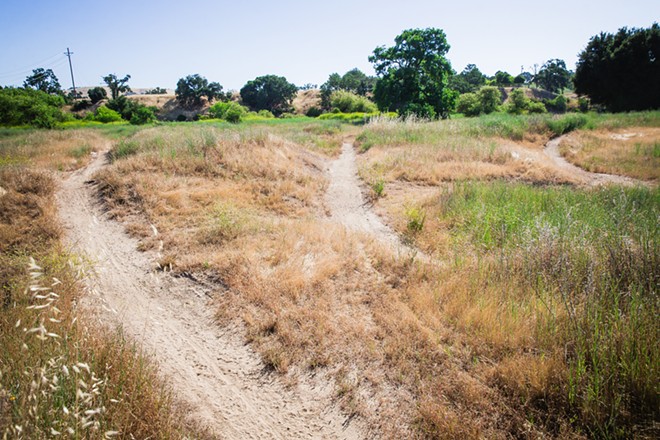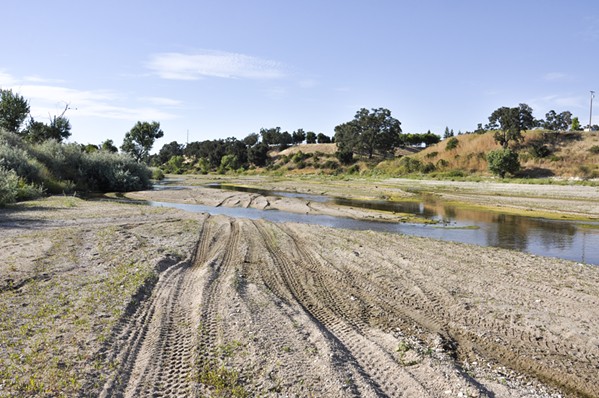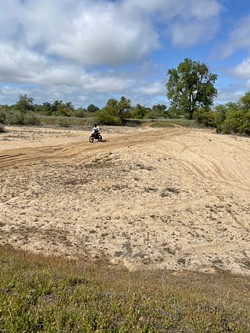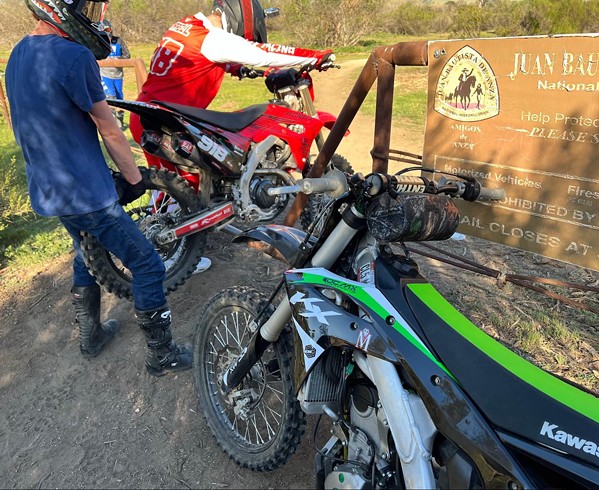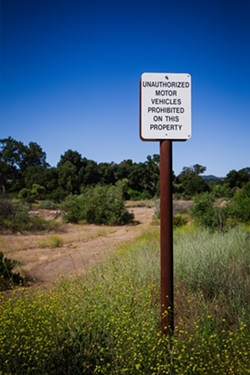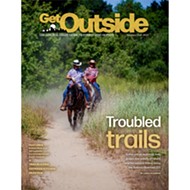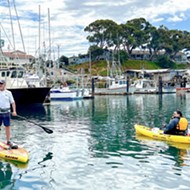FEATURE: A long-standing trail use conflict erupts along the Salinas Riverbed in Atascadero
By Camillia Lanham[
{
"name": "Newsletter Promo",
"id": "NewsletterPromo",
"class": "inlineCenter",
"insertPoint": "4",
"component": "15264767",
"requiredCountToDisplay": "0"
},
{
"name": "Ad - Medium Rectangle CC01 - 300x250 - Inline Content",
"class": "inlineCenter",
"insertPoint": "8",
"component": "15582119",
"requiredCountToDisplay": "12"
},{
"name": "Ad - Medium Rectangle LC01 - 300x250 - Inline Content",
"class": "inlineCenter",
"insertPoint": "18",
"component": "15582122",
"requiredCountToDisplay": "22"
},{
"name": "Ad - Medium Rectangle 9 - 300x250 - Inline Content",
"class": "inlineCenter",
"insertPoint": "28",
"component": "15582121",
"requiredCountToDisplay": "32"
}]
Knobby tire tracks crisscross through soft sand. Intermingled with foot, paw, and hoof prints, they occasionally overlook the late spring remnants of the Salinas River as it runs through Atascadero.
Some of those hoof prints were left by Kathryn McGinnis’ “big bay ranch horse,” which she takes to the Juan Bautista de Anza Historic Trail on Saturdays and Sundays. She’s ridden her horse on the riverbed trail for 10 years.
“He’s just a good guy,” she said of the quarter horse she’s had since he was 7 years old and “a little one-sided.” “He takes good care of me.”
When he gets spooked, he doesn’t buck, McGinnis said, but he does react to the dirt bikes that ride the same trails in the riverbed and its riparian corridor. Sometimes, he starts to spin—which is just as dangerous for the rider.
“If they were to come out of the bushes or come around the corner, oh my God. … It’s only because I’m more afraid to come off than I am to stay on that I’ve stayed on,” she said. “It’s a 1,200-pound animal and when they get scared, you’ve got your life in your hands. … And a motorcycle, you can turn that off in an instant. You can’t do that with a horse.”
Trail etiquette, McGinnis and other horseback riders said, is super important for multi-use trails. Horses have the right of way over hikers, bikers, and “especially over motorized vehicles,” she said. Those unspoken rules call for motorcycle riders to pull off to the side of the trail and kill their vehicles, but that doesn’t always happen.
Motorized vehicles aren’t allowed on the historic trail and haven’t been for decades. But dirt bikes, ATVs, and even trucks have left tracks through the Salinas Riverbed and on its banks and trails for as long as anyone can remember.
“I would say that it’s gotten worse,” McGinnis said. “It used to be that most of the people you’d encounter were very polite. As soon as they’d see you, they’d kill their engine. They’d say hi.”
She attributes an uptick in incidents with motorcycle riders to the last few winters of heavy rain that have filled the North County river. A soggy, wide river bottom pushed motorized vehicles up to higher ground and concentrated them into fewer areas, specifically an area that’s accessible from a horse staging arena on Ferro Carril Road behind Home Depot in Atascadero.
“Where they used to ride up in Paso [Robles], they just couldn’t get in there. It was just too wet for too long, and they could get into this part of the river, and so they started coming down,” she said. “That meant more people coming who weren’t accustomed to riding around horseback riders … and they didn’t want to be.”
One day when she was riding, she heard engines and tried to find a space that was as open as possible, so the motorcyclists could see her and her horse. There were three dirt bikes, and each rider—a man and two younger boys—killed their engine.
“And I said, ‘You’re not supposed to be down here,’” McGinnis said. “He yelled at me, turned his motorcycle back on, turned it around, revved it as loud as he can, and rooster-tailed it out of there. And he left the two young boys behind. … It was just a very rude and disrespectful display by an adult, which is just unacceptable.”
Luckily, she added, her horse didn’t respond that time because he could see the motorcycles. It’s when he can hear them but can’t see them that he starts to get antsy. McGinnis called 911, and the dispatcher who responded said that the police wouldn’t be coming.
It’s only the second time she’s ever made a phone call like that. The other time, McGinnis said, was a similar situation, but worse.
“It was three kids that were just riding wild and crazy down there. Just crazy, crazy, crazy everywhere and just would not stop at all,” she said. “It just takes, as you know, those one or two people” to ruin things for everyone.
Private property, public trail
Most of the Juan Bautista de Anza Trail Historic Trail in Atascadero runs through private property owned by Atascadero Mutual Water Company.
“We own about 400 acres of riverfront property and it’s all within the city limits, and our board of directors encourages the use of that property for hiking, biking, and equestrian use,” water company General Manager John Neil said. “It’s been a long-standing policy … that no off-road vehicles are allowed.”
That property runs from just behind Home Depot on the north end up to Atascadero’s wastewater treatment facility on the south end. The county side of the riverbed, which includes the actual river channel, is all private property, Neil said.
He’s been with the water company, a co-op owned by Atascadero residents, for more than two decades. Off-road vehicle use has always been an issue on water company property, he said, adding that he didn’t think recent activity has been unusual.
“One thing I have noticed though … is that there’s not as much of courtesy between users,” he said. “That’s one of the bigger complaints that I’ve received from users of the trail.”
Board meeting minutes going back to the 1970s show a consistent stance against motorized vehicles on water company property. In 1974, the board denied a shareholder request to ride motorcycles in the riverbed. In 1983, the board voted to consider motorcycles on water company property as trespassing. In 1986, the board sent a letter to the city authorizing it to cite motorcycle users for trespassing.
A 2004 agreement between the National Park Service and the water company for the approximately 4-mile segment of historic trail that passes through water company property specifies that its use is for people on “foot, bicycle, or horseback.”
The agreement also notes five access points, including the arena behind Home Depot. But the trail itself isn’t relegated to one specific route. Some portions of the segment through Atascadero are more defined than others with spurs and offshoots as well as the water company’s access road.
“We have not been able to come up with a way to allow the horses to come in but don’t allow the motorcycles,” he said.
Several signs at trail access points and along the trail note that motorized vehicles, fires, firearms, and camping aren’t allowed.
Neil said the company’s concerns with motorized vehicle use include water quality protection, as there are 15 water wells along the river and trail. They crowd the edge of the property line, Neil said, above the river channel. Some are shallow and some are deeper, but all of them provide water to Atascadero residents. A better riparian environment means higher water quality, Neil said.
Another issue is what motorcycles do to the water company’s roads and infrastructure. Every year, Neil said, they put a magnesium salt on the decomposed granite to keep the dust down, but motorcycle wheels chew up that layer making it less effective. In addition, motorcycles have damaged well pump houses, and they use water company roads as jumps, which the company has barricaded.
Staff reports from 2003 highlight motorcycles accessing the riverbed from the Lakes of Atascadero subdivision, which backs up against the trail. The water company fenced off some of those spots—an ongoing battle as new access points get created. Every year, the water company sends out a reminder letter to the homes along the trail that motorized vehicles aren’t allowed on the property.
“One of the people who lives off Ferro Carril Road actually cut a trail onto water company property, so that motorcycles can access it,” Neil said. “So, I’m probably going to fence it, which is another expense.”
All of the additional maintenance required falls back on the ratepayers, including the cost of repairing damaged or destroyed fencing designed to keep motorcycles out.
“I don’t think the water company would have an issue if they would tend to stay in the river channel. But it’s when they get on the well roads and stuff. It just creates more maintenance for us,” Neil said. “I just wish we could find a place for them to ride. That’s the real solution to it.”
No place close
Since he was 11 years old, Simon Lorden’s been riding dirt bikes. The Atascadero native is now 23.
“I ride dirt bikes every weekend for sure, sometimes in the mornings before I go to work,” he said. “There isn’t anywhere to ride in Atascadero other than the riverbed.”
The closest place, he said, is Turkey Flats OHV area of Navajo Road in Los Padres National Forest.
When he was in high school, Lorden said, he and his buddies would drop into the riverbed from Halcon Road and ride all the way up to Templeton, go to the market, get gas, and ride back.
“That was our fun, was going all the way up to a different town and riding back,” he said. “Now, we can only ride for an hour.”
The river’s water level over the last couple of winters has truncated the distance they can ride, and motorcycle riders have had to move “all the way up” and find new trails, he said.
“I can only speak for me and my friends, … anytime we see people, we see horses, it doesn’t matter what it is, somebody walking a dog, we’ll turn our bikes off of cruise by real slow,” he said. “Every interaction I’ve had with people in the riverbed has been good.”
Earlier this year, he said he ran into some horseback riders on the trail, turned his bike off, said hello, and had a good interaction. He doesn’t go super fast on the trails where line of sight isn’t very far because he doesn’t want to hit anyone. But he’s also had people take pictures of him and his truck while he was loading up his bike in the arena.
Growing up, Lorden knew that it was illegal to ride in the riverbed, but it was an outlet for him.
“You see signs that say no motor vehicles and stuff, but it also says no camping and people are doing that,” he said.
With a 1-year-old at home who’s getting ready to mount his first electric bike, Lorden said his son is going to have to ride somewhere as he gets older. And it would be nice if the family didn’t have to take it a big trip to make it happen. It would be nice, he said, if Atascadero could create a space that’s just for UTVs or ATVs—vehicle categories that include motorcycles.
“Somewhere that we could be responsible for, make a difference in the community, and also be able to have fun,” Lorden said. “I just want to be able to ride without getting in trouble.”
Enforcement problems
Many of the incidents in the riverbed, according to horseback riders who wished to remain anonymous due to fear of retaliation, occur with young teenagers.
One horseback rider said she used to be OK with sharing the riverbed with motorcycles as long as it was separate, but that changed one day. She ran into two kids on dirt bikes and was able to talk to one of them about trail etiquette and what was allowed on water company property, but the other one took off.
“That kid was waiting by the pumphouses, and when I would ride up, they would ride at me the whole way down the water service roads,” she said. “It was so dangerous. … So that day I became a total believer.”
She no longer felt that off-road vehicles could share the riverbed—whether in the city or county. The horseback rider also started calling 911 for vehicles in the riverbed. She and McGinnis aren’t the only ones, but many horseback riders say that the Police Department hasn’t always been responsive.
During a Feb. 27, 2024, Atascadero City Council meeting, several people spoke during the community forum (30 minutes designated for residents to speak). Some lived in the Lakes subdivision, others were trail users—all of them complained about motorcycles.
One resident who lives at the end of Tampico Road on the edge of the riverbed said that motorcycles drive onto her property through barricades and cones to access the river.
“We had to basically emergency put up a gate,” she said. “It’s a safety hazard for me. I don’t appreciate it. I’ve called the Police Department, personally, about eight times and reported it.”
Resident Vicki Janssen told the council that she believed motorcycle riders are becoming more aggressive, getting closer and closer to people on foot, bike, and horseback, which isn’t safe.
“I had an incident where I could hear a motorcycle coming and I stopped my horse in the trail, and they were going so fast that one of them had to lay down his bike, and he tore open his knee, and now I’m rendering first aid and I had to call his grandmother to take him to the hospital,” she said. “I don’t have a solution. … We need to bring the sides together, try to find a win-win where we can all enjoy multi-use recreation on the trails. … We need to find a way to educate people who are using the trail.”
For Atascadero’s new police chief, that meeting was a starting point. He heard concerns from property owners concerned about noise and those whose land was being damaged, property like fencing being destroyed, animals such as goats and pigs being disturbed. He heard from trail users who were worried about their own safety. He heard from residents who voiced issues about the environment, such as vehicles running over beaver dams.
“Not only do we have this issue with motorcycles, but we have this issue with citizens,” Chief Dan Suttles said. “Our primary goal is to keep the peace, … so find solutions.”
The council directed city staff to try and meet with stakeholders, which Suttles did. In April, the Atascadero Police Department posted a notice on its Facebook page.
“We need your help to address a growing concern: illegal motorcycle riding in the Salinas Riverbed,” it said. “This reckless behavior not only violates our local laws but also endangers public safety and harms our precious environment.”
The response was swift and critical, with hundreds of comments. Many who responded to the post referenced homeless camps, saying they do more damage than the dirt bikes do. Others lamented that the riverbed was the only place where kids could ride their motorcycles. Several said the Police Department should focus on more important issues.
“Comparing enforcement of OHV riding in the riverbed and resources we put toward homelessness, it’s just been night and day,” Suttles said. “We haven’t had a patrol in the riverbed, but I can tell you we deal with every single day putting resources toward our homeless population.”
Suttles said the city receives noise complaint and trespassing calls about motorcycles in the riverbed. And while city municipal code does outlaw motorized vehicles in the riverbed, it’s been hard to enforce for several reasons.
It’s difficult to identify riders, who are usually covered head to toe in safety gear including a helmet. Their bikes aren’t necessarily registered and don’t have license plates. Catching them is near impossible, and he’s not going to put his officers or a rider in danger with a high-speed chase through the riverbed. Plus, the city/county boundary zig-zags through the Salinas River, and the city Police Department doesn’t have jurisdiction in the county.
The SLO County Sheriff’s Office does respond to trespassing calls from private property owners along the Salinas River but doesn’t receive very many, sheriff’s spokesperson Tony Cipolla said.
Suttles said his goal moving forward is to find some sort of balance that addresses the issues at hand.
“We do have the ability to have a presence in the riverbed,” Suttles said. “We know where people like to drop into the riverbed, and if we can be there and talk to people, then that’s great. I’d like to take a softer approach.”
That starts with education, “the least amount of enforcement,” and escalates with the scale of the problem to “the greatest amount of enforcement.”
“If someone is doing something extremely dangerous, we will treat it as such,” he said, adding that this is how the Police Department now tries to approach a lot of situations.
“Riding dirt bikes is not inherently dangerous,” said Suttles, who rides both dirt bikes and horses. “It’s not ever going to be safe riding a bike next to a horse.”

